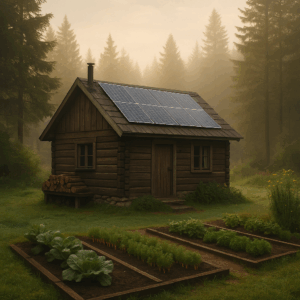How to Get Started Living Off the Grid
Living off the grid isn’t just about escaping—it’s about rebuilding. Rebuilding your relationship with energy, food, space, and time. Reclaiming control over how you live, spend, grow, and connect.
It can feel overwhelming at first. There’s the gear, the systems, the skills you may not yet have. But it doesn’t start with land or solar panels. It starts with mindset. And it starts right where you are.
Rethink What “Off-Grid” Really Means
For many, “off-grid” conjures images of total isolation—remote cabins, no internet, growing every bite of food. But the reality is more nuanced.
Living off the grid simply means relying less on fragile systems and more on your own preparation, resilience, and choices. You can live in a suburban home and be more off-grid than someone rural with no power plan.
The key? Intentional independence.
Step One: Audit Your Dependencies
Start by identifying the areas of your life where you rely on centralized systems:
-
Power: Are you dependent on the grid for 100% of your energy needs? What could you back up with solar, battery, or manual alternatives?
-
Water: Is your home prepared for disruption? Do you understand basic water collection, storage, and filtration?
-
Food: What percentage of your meals come from packaged, processed, or long-supply-chain sources? Could you grow just one thing?
-
Waste: How do you manage waste, compost, and reuse?
-
Information and attention: Are your digital habits serving you, or keeping you tethered?
Start there. Awareness is the first tool.
Step Two: Choose Simplicity Over Perfection
Don’t wait for perfect land, the full setup, or a blank slate. Start with what’s within reach.
-
Grow something—anything—on your balcony or in a windowsill.
-
Learn to cook without power, even if just on weekends.
-
Practice water conservation and begin basic storage.
-
Unplug devices overnight. Cut one digital subscription.
-
Take a weekend without screens. Reflect.
Every small action builds the muscle of independence. Off-grid living is cumulative.
Step Three: Build Skills Before You Buy Systems
Too many people think the journey starts with gear. It doesn’t.
You’ll save time, money, and frustration by learning first:
-
How to filter water manually
-
How to build or cook with fire safely
-
How to read the land, track sun and shade
-
How to identify your local edible plants or grow in small containers
-
How to navigate without constant connection
A low cost solar setup won’t make you independent if you don’t know how to ration battery use or spot a faulty cable. Start with understanding, not equipment.
Step Four: Redefine Success
Living off-grid doesn’t mean being invisible. It doesn’t mean poverty or fear. It means purpose. Preparedness. And most of all, freedom.
Your version might include a camper and hotspot. Someone else’s might be a full homestead. The only rule is that you move toward less reliance—and more intention.
Final Thought: Start Where You Are
You don’t need 40 acres. You don’t need permission. You just need to begin.
Start by noticing what you’re plugged into. Then slowly, gently, begin to unplug. One wire, one habit, one mindset shift at a time.
This life isn’t for everyone. But if it’s calling you—you already know.


